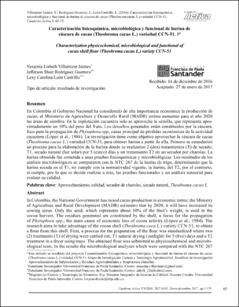Caracterización fisicoquímica, microbiológica y funcional de harina de cáscara de cacao (Theobroma cacao L.) variedad CCN-51
Characterization physicochemical, microbiological and functional of cacao shell flour (Theobroma cacao L.) variety CCN-51
Artículo de revista
2017-03-29
Revista Activa Tecnológico De Antioquia
En Colombia el Gobierno Nacional ha considerado de alta importancia económica la producción de cacao, el Ministerio de Agricultura y Desarrollo Rural (MADR) estima aumentar para el año 2020 las áreas de siembra. En la explotación cacaotera solo se aprovecha la semilla, que representa aproximadamente un 10% del peso del fruto. Los desechos generados están constituidos por la cáscara, foco para la propagación de Phytophora spp, causa principal de pérdidas económicas de la actividad cacaotera (López et al., 1984). La investigación tiene como objetivo aprovechar la cáscara de cacao (Theobroma cacao L.) variedad CCN-51, para obtener harina a partir de ella. Primero se estandarizó un proceso para la elaboración de la harina donde se realizaron 2 (dos) tratamientos (T) de secado; T1, secado natural (luz solar) por 5 (cinco) días y un tratamiento T2 en un secador por charolas. La harina obtenida fue sometida a unas pruebas fisicoquímicas y microbiológicas. Los resultados de los análisis microbiológicos se compararon con la NTC 267 de la harina de trigo, determinando que la harina secada en el T1, no cumple con la normatividad vigente, la harina, del T2, por el contrario, si cumple, por lo que se decide realizar a ésta, las pruebas funcionales y un análisis sensorial para evaluar su calidad. In Colombia, the National Government has raised cacao production in economic terms; the Ministry of Agriculture and Rural Development (MADR) estimates that by 2020, it will have increased its sowing areas. Only the seed, which represents about 10% of the fruit's weight, is used in the cocoa harvest. The residues generated are constituted by the shell, a focus for the propagation of Phytophora spp., the main cause of economic loss of cocoa activity (López et al., 1984). The research aims to take advantage of the cocoa shell (Theobroma caca L.) variety CCN-51, to obtain a flour from this shell. First, a process for the preparation of the flour was standardized where two (2) treatments (T) of drying were carried out; T1 natural drying (sunlight) for 5 (five) days and a T2 treatment in a dryer using trays. The obtained flour was submitted to physicochemical and microbiological tests. In the results the microbiological analyzes which were compared with the NTC 267 of the wheat flour determined that the dried flour in the T1 does not comply, in contrast to the flour of the T2 that does comply with the current norm. For this reason, A Functional tests and a sensory analysis were carried out to evaluate the quality of the flour.
Descripción:
Caracterización fisicoquímica, microbiológica y funcional de harina de cáscara de cacao (Theobroma cacao L.) variedad CCN-51..pdf
Título: Caracterización fisicoquímica, microbiológica y funcional de harina de cáscara de cacao (Theobroma cacao L.) variedad CCN-51..pdf
Tamaño: 1.387Mb
 PDF
PDF
 LEER EN FLIP
LEER EN FLIP
Título: Caracterización fisicoquímica, microbiológica y funcional de harina de cáscara de cacao (Theobroma cacao L.) variedad CCN-51..pdf
Tamaño: 1.387Mb
 PDF
PDF
 LEER EN FLIP
LEER EN FLIP
















